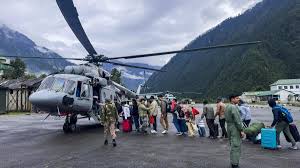Massive Evacuation Operation Successfully Concludes in North Sikkim as 76 Army Personnel Airlifted from Chaten
In a major relief operation following days of intense rainfall and landslides in North Sikkim, a total of 76 army personnel were successfully airlifted on Saturday from the remote area of Chaten.
The region, severely affected by heavy monsoon downpours, had witnessed multiple landslides that cut off crucial road links, rendering several locations inaccessible and stranding both civilians and military personnel.
According to official sources, the army personnel were evacuated as part of a meticulously coordinated airlift operation involving three MI-17 helicopters.
These aircraft transported the stranded soldiers from Chaten to the Pakyong Greenfield Airport, marking the formal conclusion of what authorities have described as a “complex and challenging” evacuation mission.
The airlift of the army personnel comes days after a successful large-scale operation to rescue over 1,600 stranded tourists from the disaster-affected areas.
“Altogether, 76 army personnel were airlifted by three MI-17 helicopters. The air evacuation operation from Chaten has concluded today with the helicopters transporting army personnel from Chaten to Pakyong Greenfield Airport,” an official statement confirmed.
Relief Supplies Also Airdropped to Chaten
In a parallel humanitarian effort, one MI-17 helicopter was dispatched from Pakyong Airport earlier in the day, loaded with approximately 1,300 kilograms of essential relief materials. These supplies, intended for both army personnel and civilians still in the isolated zone, included food, water, medical kits, and other critical items.
Onboard the aircraft were five senior officials from the Food and Civil Supplies Department, who were tasked with overseeing the distribution of the aid and assessing further requirements on the ground.
The helicopter was also scheduled to return with some of the army personnel stationed in Chaten as part of the ongoing evacuation cycle.
Catastrophic Rainfall and Landslides Paralyse Region
North Sikkim, known for its rugged terrain and scenic beauty, has been battered by relentless rainfall over recent days. The extreme weather conditions triggered a series of devastating landslides across the region, which not only blocked key transportation routes but also isolated entire towns and villages.
The worst affected areas included the popular tourist destinations of Lachen, Lachung, and Chungthang, where over 1,600 domestic and international tourists were reported to be stranded.
The challenging task of rescuing these tourists was undertaken by a multi-agency team comprising the Indian Army, the National Disaster Response Force (NDRF), the State Disaster Response Force (SDRF), the Border Roads Organisation (BRO), and the Mangan district administration.
Their tireless efforts included the use of heavy equipment to clear debris, as well as multiple helicopter sorties to airlift tourists from areas where road access was completely blocked. Over 140 tourists were safely evacuated by air, while others were escorted out once the roads were temporarily cleared.
Tragedy Strikes: Three Soldiers Dead, Six Missing
Amid the ongoing rescue and relief efforts, tragedy struck on the evening of June 1 when a massive landslide slammed into a military camp located in Chaten.
The catastrophic slide caught the personnel by surprise and led to a significant loss of life. Three army soldiers were confirmed dead at the scene, while four others sustained serious injuries and had to be immediately transported to medical facilities for treatment.
Most concerning, however, is the status of six additional army personnel who have been reported missing since the incident. Search and rescue teams, including specialized personnel from the army and state disaster units, are continuing exhaustive efforts to locate the missing soldiers.
“Efforts are underway to locate the missing soldiers. Ground search operations have been intensified, despite the challenging weather conditions and terrain,” an official from the rescue command stated.
Government Assures Continued Monitoring and Support
In the wake of the calamity, the Sikkim state government has reiterated its commitment to ensuring the safety and welfare of all individuals affected by the disaster. Senior officials have been deployed to the region to coordinate response efforts, assess damages, and ensure the rapid distribution of aid.
A government spokesperson said, “The state administration is monitoring the situation very closely. Every effort is being made to support the army, civilians, and local communities affected by this natural disaster. Relief materials, emergency medical care, and logistical support are being provided on an urgent basis.”
He further emphasized that the state, in collaboration with central agencies, would continue to prioritize restoring infrastructure, particularly road connectivity, as a first step toward normalcy. Long-term rehabilitation plans for affected families are also under discussion.
A Test of Resilience and Coordination
The recent developments in North Sikkim serve as a sobering reminder of the region’s vulnerability to extreme weather events, especially during the monsoon season.
Yet, amid the devastation, the swift and coordinated response from multiple agencies — both civilian and military — has been widely lauded as a model of disaster management.
As the skies begin to clear and the region slowly emerges from the aftermath of the disaster, focus will now shift toward rebuilding and learning from the experience.
The airlift of 76 army personnel and the safe evacuation of over 1,600 tourists stand as testimony to the power of collective action in times of crisis.

